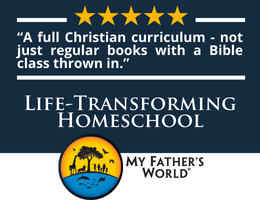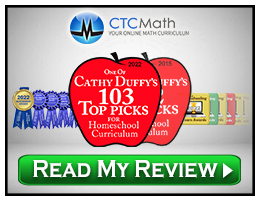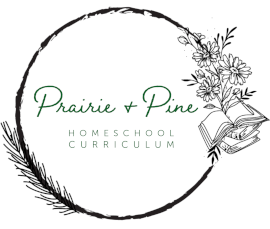The Prairie and Pine curriculum consists of literature-based unit studies. They primarily cover literature, vocabulary, composition, and critical thinking, but they delve into other subject areas related to topics in each book. Most studies are for middle and high school, but they do have a few studies for younger students.
For the elementary level, there are studies of Understood Betsy and Where the Red Fern Grows. Slow Down Christmas, a study of six short stories, can be used by the whole family. Middle school students can study The Giver, When Stars are Scattered, Where the Watermelons Grow, and Hatchet. High schoolers can choose from studies of Hillbilly Elegy; Folks, This Ain’t Normal (non-fiction book about our food system); 1984; Fahrenheit 451; Into the Wild; I Am Malala; Brave New World; and The Great Gatsby. This is a relatively new curriculum line, and studies of more books will be added.
The studies strive for a neutral approach, leaving it to parents to introduce religious aspects. Several of the high school studies are labeled “Proceed with Caution” to alert parents and teens that they deal with mature or sensitive topics. For example, in 1984, the main character’s sexual affair plays an important part in the story, and this dystopian story delves into topics such as political violence, lying, psychological manipulation, and the forced acceptance of rewritten history. Three free samples are available for those who want to check out the curriculum before buying.
Each Prairie and Pine course includes a parent guide and a student workbook. You need to obtain the literary works on your own, except for the short stories in the Christmas study, which are included in the curriculum. The courses utilize additional online resources that are free.
The Prairie and Pine books are in PDF format, although printed books are available at a higher cost. The parent guide is best used as a PDF because it has weblinks. The student workbook should be printed out or purchased as a printed book since students will write in it. It also includes many QR codes that link to resources and playlists for short stories, movie clips, articles, vocabulary definitions, artwork, speeches, and much more.
Free videos teach students to use an annotation process as they read books. They highlight words and passages, circle unknown words, write questions, make connections, and look for academic vocabulary (described on page 9 of the parent guides) that they will write in a reading log. Students learn elements of literary analysis through each study, and they will complete a culminating writing assignment, such as a literary analysis essay, a research paper, an argumentative essay, or an expository essay. Each study also has students create a final project that requires some structured writing but might involve arts and crafts, a presentation, or another means of expression. The assignments throughout the courses are designed to cover a wide range of writing and presentation styles, reflecting the Common Core State Standards for Language Arts.
Parent Guides
It should take eight weeks per study, so most students can complete four studies per school year. Pacing guides in the parent manuals show suggested schedules for completing the lesson activities, including reading the literary work.
The parent guide explains how the course works, including background on the literary work and detailed explanations of course elements like annotation, journal prompts, vocabulary activities, reading logs, and essay writing, as well as supplemental resources that are included within each study, such as videos, short stories, articles, musical analysis, and art analysis. Parents need to familiarize themselves with the guide (about 30 pages) before students begin a course.
The Prairie and Pine studies are very thought-provoking, and the work is challenging, so parents might need to adapt the studies for struggling students.
Parents will use the provided rubrics to evaluate student work (i.e., reading log entries and essays) and should go over the rubrics in advance so students understand what is expected. Some parent guides include a few optional writing prompts in an appendix that mimic those found in the AP Exam for English Literature.
Student Workbooks
Students should be able to complete most lessons independently. The student workbooks are about 100 pages long and are divided into eight sections, to be completed over eight weeks. The introduction in each workbook presents three essential questions addressed by the literary work, such as this one for the study of 1984: “Who should have the ability to control distribution of information in a society and what are the risks of censoring information?” (p. 4). By addressing questions like this, these studies require students to analyze the literature, draw on their knowledge of other subject areas (sometimes through research), and develop their own opinions.
Each section has a checklist for the elements to be completed that week. These vary for each study but might include reading a short story or a poem, watching a video or video clip, writing in response to a journal prompt, answering questions both before and after reading each chapter, sketching a scene, studying the setting, learning about the literary genre, learning about characters, writing responses to questions posed in the workbook, analyzing supplemental resources and their connection to the literary work, working extensively with vocabulary words, filling in graphic organizers, writing a movie review, researching by using QR codes in the workbook, completing a required activity (e.g., the “Cost of Living Project” in Section 2 of the workbook for Hillbilly Elegy), completing a suggested activity (e.g., “Look at a few of the leading news headlines any day this week. Choose one story, and research the opposing side of the information presented in the article,” from Student Workbook: A Unit Study with 1984, p. 5.).
The courses require a lot of writing in many forms. For example, the student workbooks present journal prompts before and after students read each chapter, and sometimes more frequently. Students also write a literary analysis essay in one of the last two units of each course and complete a creative project, such as writing a short story or creating a collage with a written explanation.
Summary
I love the creative combinations of resources used for each of these studies. I also appreciate that students have much latitude in their notetaking, journaling, and writing assignments to weigh ideas and express their own conclusions. Students will be well rewarded for the effort they invest.








